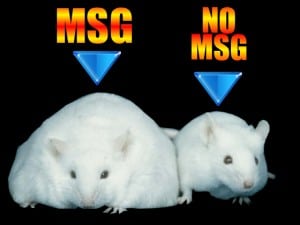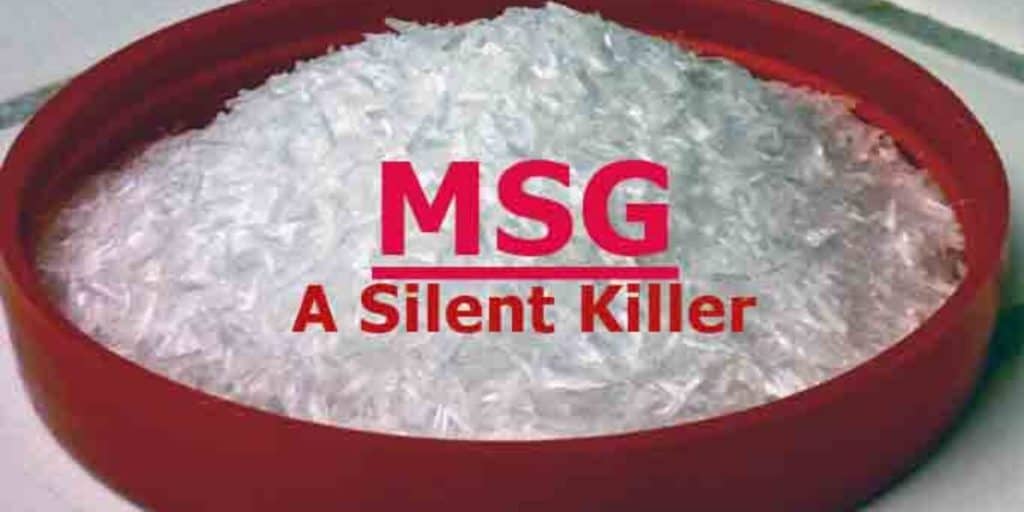“MSG is a poison”
What is the flavoring that makes you crave more of whatever it is that you’re eating?
It is not the food — it’s none other than the chemical monosodium glutamate, popularly known as MSG.
One chemical commonly used as a “flavor enhancer” is MSG. This is a poison that in some ways mimics the action of toxic metals and can cause abnormal blood pressure, muscle and joint pain, gastrointestinal and respiratory difficulties, skin rashes, and blurry vision.
It also impaired brain functioning that may include depression, dizziness, migraines, seizures, loss of balance, sleepiness, insomnia, hyperactivity in children, mental confusion, and anxiety.
In fact, the effects of MSG mimic many neurological disorders, such as Alzheimer’s and Amyotrophic Lateral Sclerosis (or ALS, also called Lou Gehrig’s disease).
Although MSG is ubiquitous and used around the world, this doesn’t mean that it’s safe. Excitotoxins: The Taste that Kills, by Rusell Blaylock, MD, describes in detail how and why MSG causes so much harm, and what people can do to minimize the damage.
In case you thought that MSG was the ultimate triumph in food additives, the article “Better Disguises through Chemistry” discusses the invention of yet a newer chemical.
This chemical tricks the taste buds into sensing sugar or salt even when it is not there. Kraft Foods, Nestle, Coca-Cola, and Campbell Soup are all working with a biotechnology company called Senomyx®, which has developed several chemicals, most of which do not have any flavor of their own but instead work by activating or blocking receptors in the mouth that are responsible for taste. They can enhance or replicate the sugar, salt, and monosodium glutamate, or MSG, in foods. . .
While food safety experts applaud efforts to reduce salt, MSG and sugar, they expressed concerns about the new chemicals, saying that more testing needed to be done before these were sold in food. [Nonetheless] since Senomyx®’s flavor compounds will be used in small proportions (less than one part per million), the company is able to bypass the lengthy FDA approval process required to get food additives on the market.
TRUTH ABOUT MSG
Conditions and Diseases
For decades worldwide, MSG has been used for decades worldwide by scientists to create obese mice and rats in diet and diabetes studies.

Since rats and mice are not naturally obese, scientists inject them with MSG when they are first born (which triples the amount of insulin the pancreas creates) to make the animal fat. The “MSG-treated rats,” as the scientists call them, are not the only ones to become obese. So do humans — because MSG appears in almost every manufactured food that contains more than a few ingredients.
All protein is comprised of amino acids. Glutamic acid, one of the amino acids, is present in protein in its bound state. The minute amounts of free glutamic acid in some natural, unadulterated proteins (such as seaweeds) are not enough to induce a reaction.
However, monosodium glutamate (MSG) is actually free glutamic acid that is released in foods through processing. When large amounts of glutamic acid are released from processed protein (along with contaminants from the manufacturing), people who eat the food may react negatively even to tiny amounts. The symptoms may react negatively even to tiny amounts. The symptoms may occur immediately after ingestion, or as much as 48 hours later.
Many researchers have determined that about 30% of the United States population experiences adverse reactions when fed MSG. In their Registry of Toxic Effects of Chemical Substances, The Centers for Disease Control call monosodium glutamate a mutagen and reproductive effector.
MSG causes many symptoms
- Endocrine dysfunction: obesity, reproductive disorders, and diabetes.
- Heart problems: angina, cardiac arrhythmia, high or low blood pressure, and rapid heartbeat.
- Gastrointestinal disorders: diarrhea, nausea and vomiting, stomach cramps, irritable bowel, rectal bleeding, and bloating.
- Muscles and joint problems: aches and pains, chills, shakes, burning, tightness, and numbness.
- Neurological disorders: depression, mood swings and rage; migraines; dizziness; disorientation; anxiety and panic attacks; hyperactivity, behavioral problems, autism, and ADD in children; Alzheimer’s; paralysis, numbness, tingling, sciatica, and seizures; brain lesions.
- Respiratory disorders: asthma, chest pain and tightness, runny nose, and sneezing.
- Eye problems: blurry vision, difficulty in focusing, augmentation of glaucoma, and macular degeneration.
- Urinary and genital conditions: frequent bladder pain, swelling of prostate or vagina, irregular menstrual spotting, and frequent urination.
- Skin conditions: hives, rash, and flushing.
- Lethargy, sleepiness, and insomnia.
- Extreme mouth dryness, mouth lesions, and swelling of face and tongue.
Where MSG is always present

Despite the harm caused by MSG, the FDA requires a “monosodium glutamate” label only for products whose ingredients are a 99% pure combination of glutamic acid and sodium. Usually, foods that contain MSG do not have to be labeled as such. Manufacturers are legally allowed to hide MSG under many different names. The following always contain MSG:
- Monosodium Glutamate (MSG), Monopotassium Glutamate (MPG).
- Glutamate, Glutamic Acid.
- Calcium Caseinate, Sodium Caseinate.
- Yeast, Yeast Extract, Yeast Nutrient, Yeast Food, Autolyzed Yeast.
- Corn Oil.
- Accent® and Aginomoto® (two brand names for the pure white crystals).
- AuxiGro®, a plant “growth enhancer” that is sprayed on growing crops (since approval from the US Environmental Protection Agency in 1998).
You also know that free glutamic acid is present when you see disodium guanylate and disodium inosinate on the label. These are expensive food additives that work synergistically with MSG. It’s unlikely that they will be used as food additives if MSG is missing — so their presence suggests that the product contains MSG.
MSG is released from protein when the protein undergoes a process called protein hydrolysis, or simply hydrolysis. Hydrolyzed protein is made through the use of fermentation, chemicals, or enzymes. The source of the hydrolyzed protein could be anything. Although hydrolyzed proteins always contain MSG, the labels usually indicate a type of protein:
- Pea Protein
- Corn Protein
- Soy Protein
- Wheat Protein
If whole peas, corn kernels, soybeans or wheat berries were used whole, they would be identified as pea, corn, soy, or wheat! Calling an ingredient “pea protein,” for example, indicates that the pea has been at least partially hydrolyzed. And if something is hydrolyzed, processed free glutamic acid is always present. The following also always indicate the presence of MSG:
- Textured Protein, Textured Vegetable Protein (TVP), Vegetable Protein, Hydrolyzed Vegetable Protein, Hydrolyzed Plant Protein, Plant Protein Extract, Hydrolyzed Protein, Hydrolyzed Oat Flour — in short, any protein that is hydrolyzed.
MSG can be created in certain food additives during processing. So, the following frequently contain MSG:

- Carrageenan (either contains some processed free glutamic acid or interacts with the milk protein in dairy products to produce MSG). Carrageenan is found in whipping cream, milk, buttermilk, cream cheese, cottage cheese, sour cream, and ice cream.
- Maltodextrin, Barley Malt, Malt Extract, Malt Flavoring.
- Flavorings, so-called Natural Flavorings or Flavors (Chicken, Beef, Pork, etc.)
- Vegetable Broth, Hydrolyzed Vegetable Broth, Bouillon, Stock.
- Gelatin.
- Pectin.
- Seasoning, Spices.
- Soy Protein, Soy Protein Isolate, Soy Protein Concentrate.
- Soy sauce (especially the cheap kind that hasn’t been fermented properly for at least two years).
- Cheeses that are made with powerful enzymes instead of rennet. Enzymes can create processed free glutamic acid because the proteins in the cheese are breaking down too rapidly. (This does not occur when rennet is used.)
- Whey Protein, Whey Protein Concentrate, Whey Protein Isolate. (Whey Protein from reputable companies should not contain MSG.)
- Protease Enzymes. (Protease supplements from reputable companies should not contain MSG.)
MSG could be in:
- Pre-packed meals.
- Frozen prepared entrees.
- Processed meats.
- Canned fish.
- Soups and stews.
- Chips and other snack foods.
- Bread and crackers.
- Gravy, bullion, and stock.
- Salad dressing.
- Fast foods.
- Personal care items: soaps, shampoos, hair conditioners, cosmetics. (The MSG is hidden in ingredients that include the words “hydrolyzed” and “amino acids.”)
- Dairy products: ice cream, frozen yogurt, and low-fat milk. (Many low-fat kinds of milk are made from powdered milk. Powdered milk includes free glutamic acid due to the way in which it is processed. If milk does not meet state requirements, a dairy will fortify its milk with powdered milk to make the product acceptable to the state. Also, ultra-pasteurization uses even higher heat than normal pasteurization, which breaks down even more milk protein — causing such high levels of processed free glutamic acid that MSG-sensitive individuals experience adverse reactions.)
- Binders and fillers for prescription medications, over-the-counter medicines, and nutritional supplements; and fluids administered intravenously in hospitals. (According to the manufacturer, Varivax-Merck Varicella Virus Live vaccine contains L-monosodium glutamate and hydrolyzed gelatin, both of which contain processed free glutamic acid.)
MSG is Used Purposely
Manufacturers have known for about 50 years that MSG’s effect on the brain makes it addicting.
They purposely add MSG to food to make people buy and eat more of their products. The FDA claims that MSG is safe to eat in any amount — despite hundreds of scientific studies with titles like “The monosodium glutamate (MSG) obese rat as a model for the study of exercise in obesity”; “Obesity induced by neonatal monosodium glutamate treatment in spontaneously hypersensitive rats: an animal model of multiple factors”; and “Hypothalamic lesion induced by injection of monosodium glutamate in suckling period and subsequent development of obesity”.
MSG can cross the placenta and the blood-brain barrier of a developing fetus during pregnancy, and portions of the blood-brain barrier even in adults. This is partly what makes it so dangerous. Another danger of MSG is that it upsets the amino acid balance in the body.
The amino acid transport system of the body, designed to convey small amounts of many amino acids at one time. But when abnormally large amounts of one or just a few amino acids flood the system, they displace other amino acids. We have more than enough glutamic acid in our diets. The body can create it from other amino acids If there is not enough dietary protein eaten to create “free glutamic acid”.
The glutamic acid that’s naturally present in intact, unprocessed proteins nourishes us. The glutamic acid that’s artificially created from a manufacturing process contains some of the same molecules that exist in antibiotics and in the cell walls of bacteria — and is carcinogenic. MSG is not a nutrient.
-NENAH SYLVER, PhD
Connect with us through our Facebook page at www.facebook.com/NAETDubai or visit: www.naetdubai.com. You will find a wealth of information here along with an opportunity to speak confidentially through WhatsApp 056-639 0197 or Phone Call 04-420 1633.
You may also email us at admin@naetdubai.com





24 Responses
I blog quite often and I really appreciate your content.
The article has truly peaked my interest. I’m going to take
a note of your site and keep checking for new information about once a week.
I opted in for your RSS feed too.
Hi DeannMFourre, thank you for your support and comment appreciated it very much. Please don’t forget to subscribe to our blog and you will receive mails once we published new blogs.
I don’t realize how I ended up being here, having said that i thought this post
was good. I tend not to know who you really are but definitely you are seeing a famous
blogger should you will not be already 😉 Cheers!
Keep this going please, great job!
Hi IonaNLuening, thank you! 🙂 we are looking forward to hearing from you on our next blogs.
Definitely believe that that you simply stated.
Your favorite justification seemed to be around the net the easiest thing to
pay attention to. I have faith that to you, I certainly get irked while people consider
worries which they plainly tend not to know about. You been able to hit
the nail upon the very best and in addition defined out the whole thing
without the need of side-effects , people could take a
signal. Will likely return to get additional. Thanks
Hi MicahJToolan, thank you for your support and comment. Please don’t forget to subscribe to our blog and you will receive mails once we published new blogs. Feel free to contact us if you need any further information.
Hi ChangSKazimi, thank you for your support. Appreciated it very much. Please don’t forget to subscribe to our blog and you will receive mails once we published new blogs. Feel free to contact us if you need any further information. Cheers!
Hi SybleYGoolia, Thank you for your appreciation and support. We are looking forward to hearing from you on our next blogs.
Hi OmarZShifman, thank you for your support and comment. We are looking forward to hearing from you on our next blogs.
Hi MaileAKirson, thank you! 😀
Sustain the awesome job !! Lovin’ it!
homepage http://www.rapremix.com/forum/index.php?action=profile;u=3423
Nice information providing by your article and I would really like to thank for your article it’s really helpful. Regards Move in Steam Cleaning in Dubai
Hi, we are glad to know that we are achieving our goals in providing information to people. We are looking forward to hearing from you on our next blogs.
Hi, thank you very much for your comment. We are glad to know that we are achieving our goals in providing information to people. Please don’t forget to subscribe to our blog and you will receive mails once we published new blogs.
“Very good article post.Thanks Again. Really Cool.”
Email us at tomprabhu@gmail.com
Thank you for your comment . Please don’t forget to subscribe to our blog and you will receive mails once we published new blogs. Feel free to contact us if you need any further information. Cheers!
Incredible points. Solid arguments. Keep up the good work.
thank you for your comment.Please dont forget to subscribe to our blog and feel free to contact us for any further details.
thank you so much for your comment.Please feel free to contact us for any further details.
Thank you so much for your comment,it good to hear that we could help you by our blogs.Please feel free to contact us for any further details and dont forget to subscribe to our blog.
This is very interesting, You are a very skilled blogger. I’ve joined your rss feed and look forward to seeking more of your great post. Also, I have shared your website in my social networks!
Thank you so much for your comment. Please don’t forget to subscribe to our blogs. Feel free to contact us if you need any further information.